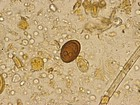Difference between revisions of "Dicrocoelium dendriticum"
Jump to navigation
Jump to search
m |
|||
| Line 12: | Line 12: | ||
[[Image:Dicrocoelium dendriticum.jpg|thumb|right|150px|''Dicrocoelium dendriticum'' - Joaquim Castellà Veterinary Parasitology Universitat Autònoma de Barcelona]] | [[Image:Dicrocoelium dendriticum.jpg|thumb|right|150px|''Dicrocoelium dendriticum'' - Joaquim Castellà Veterinary Parasitology Universitat Autònoma de Barcelona]] | ||
[[Image:Dicrocoelium dendriticum adult.jpg|thumb|right|150px|''Dicrocoelium dendriticum'' adult from horse faeces - Joaquim Castellà Veterinary Parasitology Universitat Autònoma de Barcelona]] | [[Image:Dicrocoelium dendriticum adult.jpg|thumb|right|150px|''Dicrocoelium dendriticum'' adult from horse faeces - Joaquim Castellà Veterinary Parasitology Universitat Autònoma de Barcelona]] | ||
| − | *This is a small fluke ( | + | *This is a small fluke (<1.5cm) found in the bile ducts of ruminants and some other herbivores |
| − | *The flukes migrate directly up the common bile duct to reach the bile ducts within the liver | + | *The flukes migrate directly up the common bile duct to reach the bile ducts within the liver |
| − | *''Dicrocoelium'' is rare in Britain, occurring mainly in the Hebrides, but is common in Europe | + | **They are therefore much less pathogenic than ''Fasciola'' (which burrow through the liver parenchyma) |
| − | *Small dark-brown eggs are shed in faeces | + | *''Dicrocoelium'' is rare in Britain, occurring mainly in the Hebrides, but is common in Europe |
| − | *These contain a miracidium | + | **Small dark-brown eggs are shed in faeces |
| − | *If ingested by a land snail, the flukes develop, forming cercariae | + | **These contain a miracidium |
| − | *These are excreted by the snails in slime-balls, which are collected and eaten by wood-ants | + | **If ingested by a land snail, the flukes develop, forming cercariae |
| − | *Metacercariae form inside the ants | + | **These are excreted by the snails in slime-balls, which are collected and eaten by wood-ants |
| − | *The final host is infected when ants are eaten | + | **Metacercariae form inside the ants |
| − | *The presence of metacercariae in the nerve ganglia of the ants makes them revert to a primitive behaviour pattern, whereby they cling onto herbage overnight instead of retreating to the nest | + | **The final host is infected when ants are eaten at grazing |
| − | *This enhances the likelihood of being eaten by grazing animals | + | **The presence of metacercariae in the nerve ganglia of the ants makes them revert to a primitive behaviour pattern, whereby they cling onto herbage overnight instead of retreating to the nest |
| + | ***This enhances the likelihood of being eaten by grazing animals | ||
Revision as of 23:01, 11 January 2009
|
|
Dicrocoelium dendriticum
- This is a small fluke (<1.5cm) found in the bile ducts of ruminants and some other herbivores
- The flukes migrate directly up the common bile duct to reach the bile ducts within the liver
- They are therefore much less pathogenic than Fasciola (which burrow through the liver parenchyma)
- Dicrocoelium is rare in Britain, occurring mainly in the Hebrides, but is common in Europe
- Small dark-brown eggs are shed in faeces
- These contain a miracidium
- If ingested by a land snail, the flukes develop, forming cercariae
- These are excreted by the snails in slime-balls, which are collected and eaten by wood-ants
- Metacercariae form inside the ants
- The final host is infected when ants are eaten at grazing
- The presence of metacercariae in the nerve ganglia of the ants makes them revert to a primitive behaviour pattern, whereby they cling onto herbage overnight instead of retreating to the nest
- This enhances the likelihood of being eaten by grazing animals

